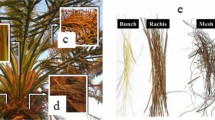Abstract
The physical properties of natural growth fibers such as chemical composition content and fiber diameter are highly affected by environmental issues such as environmental changes and fiber extraction methods. These irregularities of the natural fibers seriously affect its utilization in composite as reinforcements. In this study, taking into account the importance of the fiber tensile strength, the correlation degrees between the kenaf fiber tensile strength and the fiber chemical composition, crystallinity, orientation degree were analyzed by the grey relational analysis method. Both the kenaf single fiber and fiber bundle were used as XRD and tensile strength test sample. The chemical composition content and the FTIR were carried out to obtain a correct result of the chemical composition content. It found that for the different XRD and tensile strength test samples, the single fiber showed lower crystallinity, higher orientation degree and tensile strength compared with the fiber bundle. The cellulose content and the orientation degree got the higher correlation degree with single fiber tensile strength, which was 0.674 and 0.640. The highest factor associated with the fiber bundle tensile strength was the orientation degree, the correlation degree was 0.747. The hemicellulose content and the crystallinity also got high correlation degree with the fiber bundle strength, which was 0.687 and 0.640.
Similar content being viewed by others
References
L. Liu, Q. Wang, L. Cheng, and J. Qian, Fiber. Polym., 12, 102 (2011).
J. Rout, M. Misra, S. Tripathy, S. K. Nayak, and A. K. Mohanty, Compos. Sci. Technol., 61, 1303 (2001).
M. Abdelmouleh, S. Boufis, M. N. Belgacem, and A. Dufresne, Compos. Sci. Technol., 67, 1627 (2007).
V. Tserki, N. E. Zafeiropoulos, F. Simon, and C. Panayiotou, Compos. Pt. A-Appl. Sci. Manuf., 36, 1112 (2005).
A. Bourmaud, C. Morvan, A. Bouali, V. Placet, P. Perré, and C. Baley, Ind. Crop. Prod., 44, 343 (2013).
H. L. Bos, M. J. A. Van den Oever, and O. Peters, J. Mater. Sci., 37, 1683 (2002).
S. Fakirov and D. Bhattacharyya, “Handbook of Engineering Biopolymers, Homopolymers, Blends and Composites”, pp.3–36, Munich Hanser Publishers, Cincinnati, 2007.
Y. M. Mwaikambo and M. P. Ansell, Angew Makromol. Chem., 272, 108 (1999).
I. Duchesne, Cellulose, 8, 103 (2001).
M. Fan, Bio Resources, 5, 2307 (2010).
M. M. Kabir, H. Wang, K. T. Lau, and F. Cardona, Compos. Pt. B-Eng., 53, 362 (2013).
M. M. Kabir, H. Wang, and K. T. L. F. Cardona, Compos. Pt. B-Eng., 43, 2883 (2012).
H. Suryanto, E. Marsyahyo, and Y. S. Irawan, J. Nat. Fiber., 11, 347 (2014).
A. Bohn, H.-P. Fink, and J. Ganster, Macromol. Chem. Phys., 201, 1913 (2000).
S. Karimi, P. Md. Tahir, A. Karimi, A. Dufresne, and A. Abdulkhani, Carbohydr. Polym., 101, 878 (2014).
M. Nuruddin, M. Hosur, M. Jamal Uddin, D. Baah, and S. Jeelani, J. Appl. Polym. Sci., 133, 1 (2016).
Z. Li and C. Yu, Fiber. Polym., 15, 2109 (2014).
W. D. Yu, “Textile Material Science”, pp.43–47, China Textile Apparel Press, Beijing, 2012.
A. Taskesen and K. Kütükde, Measurement, 47, 321 (2014).
T. Li, X. L. Wang, W. Wen, and E. H. Li, Adv. Mater., 424-425, 403 (2012).
J. Zhang and J. Zhang, Text. Res. J., 80, 744 (2010).
Author information
Authors and Affiliations
Corresponding author
Rights and permissions
About this article
Cite this article
Wang, C., Bai, S., Yue, X. et al. Relationship between chemical composition, crystallinity, orientation and tensile strength of kenaf fiber. Fibers Polym 17, 1757–1764 (2016). https://doi.org/10.1007/s12221-016-6703-5
Received:
Revised:
Accepted:
Published:
Issue Date:
DOI: https://doi.org/10.1007/s12221-016-6703-5




